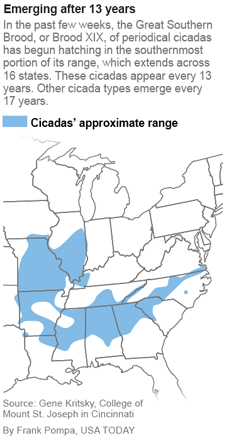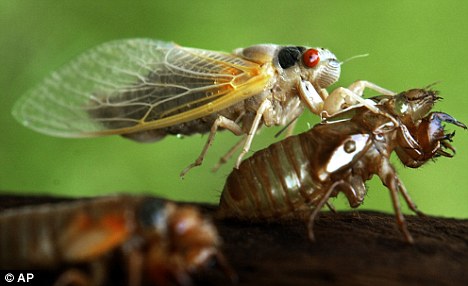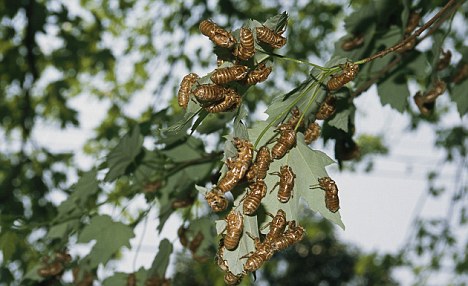They’re Back, After 13 Years!
Posted by: Loren Coleman on May 13th, 2011
They are strange-looking, they are winged, they have large red eyes, and they make loud noises. The invasion is on. Are they Mothman?

No, it’s Brood XIX of the 13-year cicadas. They have returned. The Great Southern Brood are coming out of the ground, and appearing, especially, throughout North Carolina, South Carolina, Georgia, Mississippi, and Arkansas. But Brood XIX, specifically, can be found in all of these states: AL, AR, GA, IN, IL, KY, LA, MD, MO, MS, NC, OK, SC, TN, TX, and VA. There are 15 known broods, as the offspring groups are known: 12 that come every 17 years and three that come every 13 years.

By the way, the Great Southern Brood did not appear throughout the South or in West Virginia or Ohio in 1966-1967, the years of the most Mothman sightings. Brood XIX emerged in 1972. The 17-year Brood VIII, only known from New York, was the one appearing in 1967, and VII, from Georgia, North Carolina, and South Carolina, for 1966. See here.

Brood XIX last filled U.S. skies in 1998.
They are the largest cicada variety in the world and only emerge every 13 years to breed.
Females lay their eggs in tree twigs which hatch after six to eight weeks.
The annoying din they are famous for is the sound of males singing for mates.
About an inch-long, they feed by attaching a nodule onto a branch and suck the nutrients from its juicy core.
Source.

But, as opposed to folklore about them, they are not locusts destroying crops and they do not attack, sting, or bite humans.
The red-eyed army has already reached the southern states of America, prompting many farmers to cover their crops with heavy protective netting.
“There are billions of them in the trees,” Greta Beekhuis told USA Today from her home in Pittsboro, North Carolina. “The sound of the cicadas is clearly audible over the line. When I drove from my house to the grocery store, I ran over thousands of them. They’re everywhere. The air is just thick with them.”
About Loren Coleman
Loren Coleman is one of the world’s leading cryptozoologists, some say “the” leading living cryptozoologist. Certainly, he is acknowledged as the current living American researcher and writer who has most popularized cryptozoology in the late 20th and early 21st centuries.
Starting his fieldwork and investigations in 1960, after traveling and trekking extensively in pursuit of cryptozoological mysteries, Coleman began writing to share his experiences in 1969. An honorary member of Ivan T. Sanderson’s Society for the Investigation of the Unexplained in the 1970s, Coleman has been bestowed with similar honorary memberships of the North Idaho College Cryptozoology Club in 1983, and in subsequent years, that of the British Columbia Scientific Cryptozoology Club, CryptoSafari International, and other international organizations. He was also a Life Member and Benefactor of the International Society of Cryptozoology (now-defunct).
Loren Coleman’s daily blog, as a member of the Cryptomundo Team, served as an ongoing avenue of communication for the ever-growing body of cryptozoo news from 2005 through 2013. He returned as an infrequent contributor beginning Halloween week of 2015.
Coleman is the founder in 2003, and current director of the International Cryptozoology Museum in Portland, Maine.










Wow Loren, you brought back memories. From the time I Visited San Antonio, Tx back in the early 80’s…those lil buggers will not let you sleep! ;p And the movie ‘Lucas’…thanks dude. ;p
Sounds like a ’50s era flying saucer has landed in Cave Spring GA.